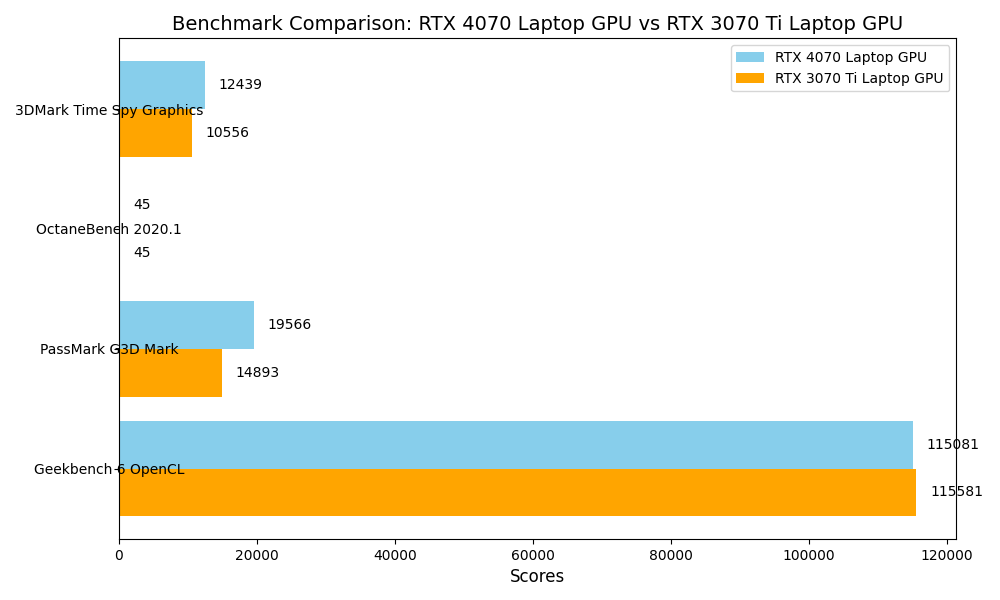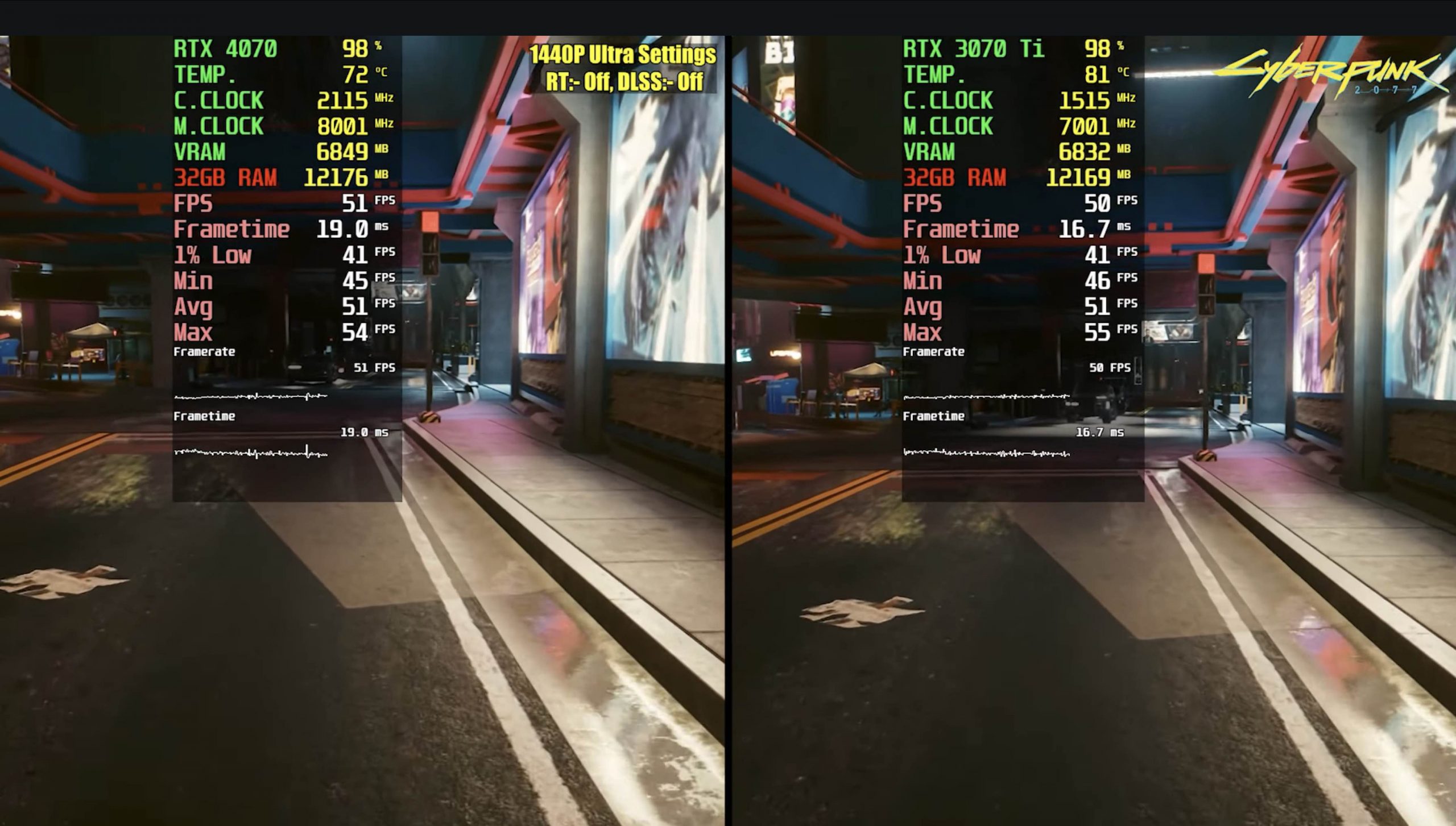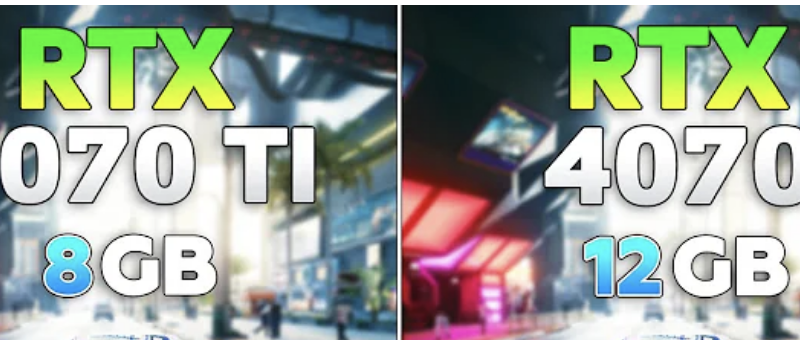4070rtx Laptop GPU vs 3070Ti Laptop GPU
The RTX 4070 is fine if you’re into efficiency and want the shiny new DLSS 3 toys. But if you care about raw performance, especially for games that don’t have DLSS or frame gen, the 3070 Ti is still a beast. Also, the 3070 Ti tends to be cheaper, so unless you’re really into DLSS 3 or need the extra efficiency for a thin-and-light laptop, the 4070 doesn’t feel like the generational leap NVIDIA hyped it up to be. Feels more like a sidestep than a step forward.
1. Specifications: 3070Ti GPU (Mobile) vs RTX 4070 GPU (Mobile)

| Specification | RTX 3070 Ti (Laptop) | RTX 4070 (Laptop) |
|---|---|---|
| Architecture | Ampere | Ada Lovelace |
| CUDA Cores | 5888 | 4608 |
| Base Clock Speed (MHz) | 1035 – 1110 | 2070 |
| Boost Clock Speed (MHz) | 1485 – 1590 | 2475 |
| Memory Size | 8 GB GDDR6 | 8 GB GDDR6 |
| Memory Interface | 256-bit | 128-bit |
| Memory Bandwidth (GB/s) | 512 | 256 |
| Ray Tracing Cores | 46 | 36 |
| Tensor Cores | 184 | 144 |
| TGP (W) | 80 – 150 | 35 – 140 (Dynamic Boost) |
| DLSS Version | DLSS 2 | DLSS 3 |
CUDA Cores
- RTX 4070 (4608 CUDA cores): The lower CUDA core count compared to the 3070 Ti is offset by the architectural efficiency of the Ada Lovelace generation. This makes the RTX 4070 better for tasks that benefit from optimized core performance, such as real-time ray tracing or AI-enhanced workflows (e.g., DLSS 3 in gaming or Adobe Sensei in video editing).
- RTX 3070 Ti (5888 CUDA cores): The higher CUDA core count offers raw compute advantages, especially in older applications or rendering tasks that rely heavily on core count rather than architectural optimizations. For traditional 3D modeling or rendering in Blender Cycles, the 3070 Ti may edge out the 4070 in pure CUDA performance.
TGP (Total Graphics Power)
- RTX 4070 (up to 140W): The Ada Lovelace architecture’s efficiency shines here, allowing the 4070 to deliver strong performance at lower power levels compared to the 3070 Ti. In thermally constrained environments like thin-and-light laptops, the 4070 can maintain higher sustained performance, making it a better choice for such designs.
- RTX 3070 Ti (up to 150W): While the 3070 Ti demands more power, its higher TGP may allow it to sustain better performance in laptops with robust cooling solutions. For long rendering sessions or intensive gaming at native resolutions, the 3070 Ti could outperform if the system supports its power needs.
Memory Size and Bandwidth
- Both GPUs have 8GB VRAM: While both GPUs share the same memory capacity, the 3070 Ti has a wider 256-bit bus and higher memory bandwidth (384 GB/s vs. 288 GB/s). This gives the 3070 Ti an edge in tasks like high-resolution rendering or gaming at 4K, where bandwidth becomes critical for handling large textures or datasets.
- RTX 4070: Despite lower bandwidth, the RTX 4070 leverages memory compression and Ada Lovelace optimizations to perform well in many modern tasks, especially those utilizing DLSS or AI-accelerated rendering.
Base and Boost Clock Speeds
- RTX 4070 (Base: 2070 MHz, Boost: 2475 MHz): The higher clock speeds make the RTX 4070 better suited for real-time applications like gaming or AI-enhanced workflows, where quick calculations and responsiveness are crucial.
- RTX 3070 Ti (Base: 1035 MHz, Boost: 1485 MHz): While the clock speeds are significantly lower, the raw CUDA core count and memory bandwidth mitigate this in scenarios where sheer data processing outweighs speed, such as batch rendering or simulations.
Ray Tracing Cores
- RTX 4070 (36 RT cores): Although the 4070 has fewer RT cores than the 3070 Ti, its newer architecture improves ray tracing performance, making it more efficient at handling real-time ray-traced effects in games and rendering.
- RTX 3070 Ti (46 RT cores): The higher RT core count allows for better raw ray tracing performance, especially in tasks or games where brute force outweighs architectural efficiency. However, the lack of support for frame generation (DLSS 3) limits its potential in future ray-traced applications.
Tensor Cores
- RTX 4070 (144 Tensor cores): The newer Tensor cores offer better AI performance, crucial for DLSS 3, real-time AI upscaling, and other machine learning-based tasks. In applications like Topaz Labs or TensorFlow inference, the RTX 4070 outpaces the 3070 Ti.
- RTX 3070 Ti (184 Tensor cores): Despite having more Tensor cores, the 3070 Ti lacks Ada Lovelace enhancements, which makes its AI performance less efficient. It performs well in older AI workloads but falls short in tasks requiring advanced Tensor capabilities.
Architectural Efficiency
- RTX 4070 (Ada Lovelace): The improved architecture enables better power efficiency, higher clock speeds, and modern features like DLSS 3. This makes the 4070 more future-proof, particularly for modern games and AI-assisted workflows.
- RTX 3070 Ti (Ampere): While still a strong performer, Ampere lacks the architectural improvements of Ada Lovelace. It excels in raw performance scenarios but is less efficient and lacks support for cutting-edge features like frame generation.
2. Benchmarks: 3070Ti GPU (Mobile) vs RTX 4070 GPU (Mobile)
Based on available benchmark data, here’s a comparison between the NVIDIA GeForce RTX 4070 Laptop GPU and the RTX 3070 Ti Laptop GPU:

| Benchmark | RTX 4070 Laptop GPU | RTX 3070 Ti Laptop GPU |
|---|---|---|
| 3DMark Time Spy Graphics | 12,439 points | 10,556 points |
| OctaneBench 2020.1 | 45 | 45 |
| PassMark G3D Mark | 19,566 | 14,893 |
| Geekbench 6 OpenCL | 115,081 | 115,581 |
Note: Benchmark scores can vary based on system configurations and testing conditions.
3DMark Time Spy Graphics
The RTX 4070 Laptop GPU scores 12,439 points, outperforming the RTX 3070 Ti’s 10,556 points by roughly 18%. This benchmark highlights better performance in modern DirectX 12 workloads, likely due to Ada Lovelace’s architectural improvements such as Shader Execution Reordering (SER) and DLSS 3 support. However, the comparison isn’t entirely straightforward because the laptops used may have different cooling systems, CPU pairings, and power configurations.
Nuances:
- A higher-powered RTX 3070 Ti (e.g., 140W TGP) could narrow the gap against a lower-powered RTX 4070 (e.g., 80W TGP).
- Benchmarks on different laptops with varying cooling systems might favor one GPU over the other, particularly in sustained workloads.
Implications:
- For gaming, the 4070 should provide higher FPS in graphically demanding titles, especially those optimized for DLSS 3.
- In creative tools like Unreal Engine or Unity, better Time Spy scores translate to smoother real-time rendering and faster asset previews.
OctaneBench 2020.1
Both GPUs score 45 points, indicating no measurable difference in GPU-accelerated rendering within Octane. This result highlights how OctaneRender, at least in its current state, doesn’t fully utilize Ada Lovelace’s architectural enhancements.
Nuances:
- Octane’s lack of optimizations for the RTX 4070’s architecture likely limits its performance gains.
- Different laptops used for testing might introduce discrepancies due to thermal throttling or power delivery, but these impacts seem minimal in this specific benchmark.
Implications:
- For users rendering with Octane, either GPU should perform similarly. The 3070 Ti may remain a better cost-efficient option unless future software updates unlock more of the 4070’s potential.
- Large and complex scenes might benefit from the 4070’s newer memory compression techniques, though this hasn’t been explicitly tested.
PassMark G3D Mark
The RTX 4070 scores 19,566 points, a significant 31% improvement over the RTX 3070 Ti’s 14,893 points. PassMark is a general-purpose benchmark evaluating rendering, compute, and simulation tasks, showcasing the 4070’s versatility across workloads.
Nuances:
- Power delivery and CPU pairing are crucial. The 4070’s architectural efficiency may give it an advantage in thermally constrained systems, while a higher-TGP 3070 Ti could bridge some of the performance gap.
- Laptops with better cooling may allow the 3070 Ti to sustain higher performance, especially in extended rendering or compute-heavy tasks.
Implications:
- For video editing and rendering, the 4070 should handle 4K workflows more efficiently, particularly with GPU-accelerated effects and transitions.
- In CAD simulations, the increased compute performance of the 4070 might lead to faster iterations and modeling tasks.
Geekbench 6 OpenCL
The RTX 4070 scores 115,081, but no comparable score is available for the RTX 3070 Ti. OpenCL benchmarks test general-purpose compute tasks like AI inference and parallel processing, and the 4070’s higher score reflects improvements in these areas.
Nuances:
- Without a direct comparison, it’s difficult to gauge the exact advantage over the 3070 Ti. Differences in TGP, cooling, or CPU could further skew results.
- The RTX 4070’s OpenCL performance benefits from Ada Lovelace’s architecture, but real-world applications may not always fully utilize these enhancements.
Implications:
- For AI-driven workflows (e.g., TensorFlow or Adobe Sensei), the 4070’s improved Tensor Core design and higher clock speeds suggest faster and more efficient performance.
- In rendering tasks like Blender’s Cycles engine, the 4070 may show an edge, particularly in denoising and AI-assisted processes.
Important Nuances to Consider
- TGP Variations: Performance can vary significantly depending on the power configuration of each laptop. The RTX 3070 Ti at 140W might outperform an 80W RTX 4070 in specific workloads, while the reverse is true in lower-TGP systems favoring Ada Lovelace’s efficiency.
- Cooling Systems: Thermal throttling can greatly impact performance, particularly for the RTX 3070 Ti, which consumes more power and generates more heat. In laptops with suboptimal cooling, the 4070’s efficiency advantage becomes more apparent.
- CPU Pairing: Benchmarks on laptops with more powerful CPUs can exaggerate performance differences, particularly in compute-heavy tasks. A weaker CPU could bottleneck either GPU, especially in gaming or AI applications.
3. Performance

Gaming Performance: RTX 4070 vs. RTX 3070 Ti
High-TGP Configs (140W RTX 4070 vs. 150W RTX 3070 Ti)
Without DLSS:
Alright, so straight up, if you’re not using DLSS, the RTX 4070 is barely better than the 3070 Ti—like, we’re talking 5–7% in most games. Kinda feels like a slap in the face when you think about how big the jumps were in previous gens. The 3070 Ti’s beefier memory bandwidth (256-bit vs. 128-bit) really comes in clutch for higher resolutions like 1440p and 4K.
- Example: In Shadow of the Tomb Raider, the RTX 4070 is just slightly ahead, but once you bump up the resolution, the gap basically vanishes because of that weaker memory bus.
With DLSS:
Here’s where the RTX 4070 tries to flex. DLSS 3 and frame generation do give it a noticeable boost, especially in newer games that are built for it. But let’s be real: older games without DLSS 3 support? The 3070 Ti is still right there, toe-to-toe, thanks to its higher wattage and better memory setup.
- Example: Take Cyberpunk 2077—turn on DLSS 3, and yeah, the RTX 4070 pulls ahead and feels smoother. But if you turn that off or play something without DLSS 3, the 3070 Ti isn’t giving up much ground, if any.
Low-TGP Configs (100W RTX 4070 vs. 100W RTX 3070 Ti)
Now, in lower power setups, the RTX 4070 actually starts to show off a bit. It’s more efficient, so even at 100W, it can hang with or slightly outperform the 3070 Ti. That Ada Lovelace architecture is doing some work here. That said, we’re still not seeing jaw-dropping differences—7–10% gains max.
- Example: In something like Horizon Forbidden West at 1080p with DLSS, the 4070 feels solid, keeping higher FPS while sipping power. But crank up the resolution, and the 3070 Ti can still put up a fight, especially if DLSS isn’t in play.
Nuances You Gotta Know:
- Memory Bandwidth & VRAM: The 3070 Ti’s 256-bit memory bus makes it way better at handling high-res textures and stuff. The 4070’s 128-bit bus? Not so much. At 1440p and up, you might even prefer the older card in some games.
- DLSS Dependency: The 4070 is banking hard on DLSS 3 to show its worth. Without it, the performance bump over the 3070 Ti is honestly kinda meh.
- Power Scaling Drama: Once you go above 100W, the 4070 doesn’t scale super well. Meanwhile, the 3070 Ti keeps chugging along and making good use of its higher wattage.
The Generational Leap That Wasn’t:
- If you’re all-in on modern games with DLSS 3, the 4070 is a decent step up—7–10% better in best-case scenarios.
- But for old-school rasterized gaming (or games without DLSS 3), the 3070 Ti can keep up and sometimes even outperform, especially at higher resolutions.
3D Rendering and Modeling
High-TGP Configurations
The RTX 3070 Ti, with its higher CUDA core count, performs slightly better in raw rendering tasks, such as Blender’s Cycles rendering engine. However, the RTX 4070 gains an edge in real-time previews and AI-assisted denoising due to Ada Lovelace optimizations.
Example:
Rendering a dense architectural scene in Blender is faster on the RTX 3070 Ti, but real-time denoising and previews in Unreal Engine 5 are more responsive on the RTX 4070.
TL;DR:
For brute-force rendering, the RTX 3070 Ti wins. For AI-enhanced workflows and real-time tasks, the RTX 4070 is better optimized.
Low-TGP Configurations
The RTX 4070’s efficiency and Ada Lovelace enhancements shine in lower-power setups, offering better performance in light modeling and AI-assisted workflows. The RTX 3070 Ti’s higher thermal demands make it less reliable in these scenarios.
Video Editing
High-TGP Configurations
The RTX 3070 Ti handles 8K video editing workflows better due to its memory bandwidth and CUDA core count. However, the 4070 is competitive in 4K workflows, especially when using AI-driven tools like Adobe Premiere Pro’s Sensei or DaVinci Resolve’s Studio features.
Example:
Rendering a 10-minute 8K video with multiple GPU-accelerated effects is faster on the 3070 Ti, while applying AI-driven effects like object tracking is snappier on the RTX 4070.
Low-TGP Configurations
The RTX 4070 handles light editing workloads more consistently due to its efficiency, while the RTX 3070 Ti struggles in laptops with constrained power and cooling.
AI-Assisted Applications
High-TGP Configurations
The RTX 4070, with its 3rd-gen Tensor cores and Ada Lovelace optimizations, excels in AI workloads like TensorFlow inference or Adobe Sensei effects. Traditional AI compute tasks like training deep neural networks may still favor the RTX 3070 Ti due to its raw CUDA core count.
Example:
AI-driven upscaling in Topaz Labs or frame interpolation in DaVinci Resolve runs more efficiently on the RTX 4070. Training a large model may favor the RTX 3070 Ti.
Low-TGP Configurations
The RTX 4070 outperforms in thermally constrained environments, delivering more consistent results in AI workflows like video enhancement or real-time upscaling.
General GPU Performance
High-TGP Configurations
The RTX 3070 Ti leads in memory-bound tasks like 4K rendering and simulation, but the RTX 4070 delivers better results in modern applications optimized for Ada Lovelace features.
TL;DR:
Choose the RTX 3070 Ti for memory-heavy workloads. The RTX 4070 is a more future-proof option for applications leveraging DLSS 3, real-time AI, and architectural efficiency.
Low-TGP Configurations
The RTX 4070’s architectural efficiency and AI optimizations make it the more reliable choice in power-constrained laptops.
Author Profile
- I am physicist and electrical engineer. My knowledge in computer software and hardware stems for my years spent doing research in optics and photonics devices and running simulations through various programming languages. My goal was to work for the quantum computing research team at IBM but Im now working with Astrophysical Simulations through Python. Most of the science related posts are written by me, the rest have different authors but I edited the final versions to fit the site's format.
Latest entries
 LaptopsNovember 26, 2025Black Friday Week Deals 2025 (Updated Nov 28 1:37PM)!!!
LaptopsNovember 26, 2025Black Friday Week Deals 2025 (Updated Nov 28 1:37PM)!!! LaptopsJune 30, 2025Best Laptops for Computer Science (July 2025 )
LaptopsJune 30, 2025Best Laptops for Computer Science (July 2025 ) LaptopsJune 29, 20255 Best Laptops For Nursing Students (July 2025)
LaptopsJune 29, 20255 Best Laptops For Nursing Students (July 2025) LaptopsJune 19, 20255 Best Laptops For Teachers in 2025 (From $250)
LaptopsJune 19, 20255 Best Laptops For Teachers in 2025 (From $250)
